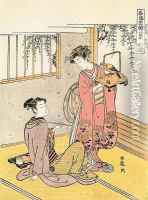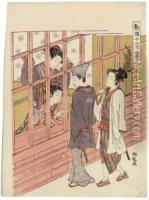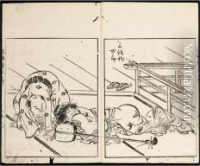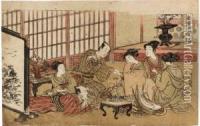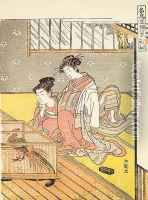Isoda Koryusai Paintings
Isoda Koryusai was a prominent Japanese ukiyo-e artist known for his contributions to the development of the floating world genre in Edo-period Japan. Although not much is known about his early life, Koryusai is believed to have been born in 1735. Before becoming an artist, he is thought to have served as a samurai under the Tsuchiya clan. After leaving his service, Koryusai moved to Edo (modern-day Tokyo) and began studying under the tutelage of Suzuki Harunobu, one of the most famous ukiyo-e artists of the time.
Koryusai initially worked in Harunobu's shadow, following his style closely. However, he eventually developed his distinct style and became known for his own artistic contributions. Koryusai is particularly noted for his innovations in the field of pillar prints (hashira-e), which were narrow, vertical prints designed to be hung on pillars. He was also instrumental in the evolution of the shunga (erotic print) genre and produced a number of notable works in this area.
Throughout the 1770s, Koryusai produced a vast number of prints, including bijinga (pictures of beautiful women), bird and flower prints (kachō-e), and genre scenes of everyday life. His work during this period was characterized by a sense of elegance and refinement, and it was well-received by the public. Koryusai's prints were particularly appreciated for their vivid depictions of the courtesans and fashionable women of Edo.
Koryusai was awarded the title of Hokkyo, a Buddhist lay rank, which he began using around 1781. This was a notable recognition of his artistic achievements and his status in the cultural milieu of the time. Despite his success, very little is known about his personal life, and much of Koryusai's biography remains a mystery.
Isoda Koryusai's death is recorded as having occurred in 1790. His artistic legacy, however, has continued to influence generations of artists, and his works are still celebrated for their beauty and historical significance in the context of Japanese woodblock printing and the ukiyo-e tradition.
